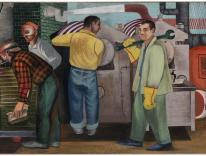In London it’s become the fashion of wealthy homebuyers to supplement already sizable residences with cavernous subterranean lairs. In Manhattan it’s to move into a sky-high aerie, priced in the tens of millions, from which it’s possible to look down on the Empire State Building. In the Bay Area it’s to snap up anything inside the city limits of San Francisco, the near entirety of which has become a bedroom community for Silicon Valley’s most monied.
Wealth has always shaped cities, but its current role in the transformation of urban centers around the world seems unprecedented, probably because there’s so much more of it, concentrated in ever-fewer hands, moving ever more fluidly and mysteriously through lightly regulated and technologically enhanced channels. Oligarch, plutocrat, or ordinary multimillionaire, the highest-net-worth property-seekers want to be in cities, or if nothing else be able to park their money in one (real estate being a good place to hide it). It may be a cliche to talk about the divide between rich and poor in places like London, New York, and San Francisco, but some cliches bear restating, especially when the divide seems increasingly inconceivable in its breadth -- the very function of a system engineered to practically ensure its further expansion. “Darwinian upscale urbanism,” as Martin Filler termed it in the New York Review of Books in April, referring specifically to former New York mayor Michael Bloomberg’s vision for the city he ran -- a place where the wealth of wealthy property owners was to trickle down to residents but instead, a researcher found, had “deleterious effects... on small business, the middle class, and taxpayers.”
It may not be easy to dig an enormous basement or live in a condo eighteen-hundred feet above street-level, but it would be even harder if there were not banks, developers, lawyers, real-estate firms, contractors, and politicians dedicated to making it possible.
Lack of transparency tends to characterize arrangements for setting aside size and height restrictions; confidentiality agreements among attending parties can make it impossible to identify through typical means the buyer or the terms of purchase. Tax abatement and exemption programs make high-priced luxury units even more appealing, even though the buyers of such properties would be unlikely to feel the full bite were it to be taken. Favorably disposed legislators can also have a way of breeding further impunity among developers. My small local paper recently reported on a firm’s response to protests over its proposal for luxury condo towers half-a-block outside the landmarked neighborhood: it presented an alternative for an even bigger project half-a-block inside it.
In New York and other U.S. cities, residential development is supposed to include provisions for affordable housing, though these are usually either ill-defined or, when they’re not, vastly insufficient. The infamous “poor door” building in Manhattan drew nearly 90,000 applicants for its fifty-five affordable rental units. New York City has held ten affordable housing lotteries in 2015 for seven hundred units; it has received 486,000 applications. ThinkProgress reports that the state of California has an affordable housing shortfall of about a million units, and the nation as a whole, about 5.5 million units.
Meanwhile, government-subsidized public housing -- when not being demonized and demolished (more than 99,000 public housing units were demolished nationwide between 2000 and 2008, a loss then-congressman Barney Frank, in seeking a moratorium, called “epic”) -- is succumbing to underfunding and neglect. The New York City Housing Authority, whose more than three hundred buildings are home to 400,000 people, has an operating deficit of $98 million this year and unmet costs of maintenance and repairs -- roofs, hot water, elevators, lead paint removal -- of $16 billion. Mayor Bill De Blasio’s proposed fix incorporates some of his predecessor’s ideas, including a mix of market-rate and affordable development on unused public-housing property like parking lots, plus raising fees for parking in those lots (assuming they’re not built on) and improving rent collection. There is no easy way to address such a situation, but the proposal seems of a piece with government’s current general reluctance -- or inability, self-induced through tax cuts and spending reductions -- to bring the imagination and energy required for important initiatives. Certainly there are people in need of help.
But need, like the diversity that’s supposed to characterize cities, seems a quaint idea when there’s so much to be had from building for the rich. The New Yorker’s Ed Caesar asked a London architect why anyone would need an enormous basement beneath an already enormous house. “You can’t put the word ‘need’ on this,” the architect answered. “The word is ‘want.’”
Please email comments to [email protected] and join the conversation on our Facebook page.
Previous Story
Anticipation and Climate Change
Next Story
Robomance

